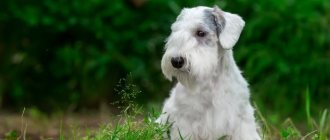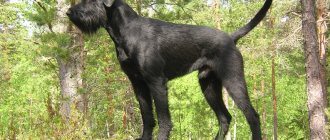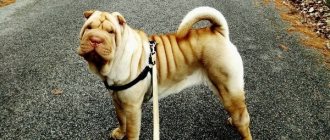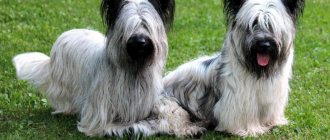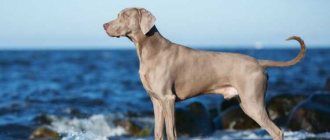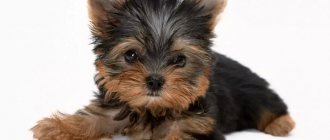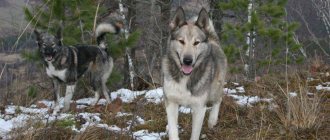- October 6, 2018
- Dogs and hunting with them
- Elena Gnilitskaya
Laika is a versatile hunting dog breed that is quite popular among hunters. She is famous for her flair, hunting passion and easy training. This is a hardy and agile dog that is effective in hunting both small animals and wild boars and bears. Let's figure out how to train a husky.
General information about the breed
The name “Lika” unites several subspecies of dogs that have similar external qualities and behavioral characteristics. The most popular subspecies for hunting are:
- East Siberian;
- West Siberian;
- Karelian-Finnish;
- Russian-European;
- Yakut Laika.
Laikas are stocky, strong dogs. The color depends on the subspecies. They have erect ears and a bushy and rounded tail that lies close to the rump or hip.
Laikas are truly hunting dogs, so they are not suitable for protection, and as companions they can bring a lot of trouble to their owner. Before purchasing a dog, it is important to learn how to raise a husky. These are very active animals that need active daily walks. Due to the call of the hunting instinct, they are prone to escape. Let's look at how to train a husky at home.
Diet
A properly formulated diet for a puppy up to one year is the foundation for a strong skeleton, ligaments, joints, and muscle mass. It is quite difficult to create a complete diet for a dog on your own, so many owners choose ready-made industrial food. Complete dry food eliminates the need to purchase additional vitamin and mineral supplements, which often have to be added to natural food.
When choosing ready-made food, you cannot save money. Cheap food contains a large amount of grain derivatives and fat, which lead to allergic manifestations and problems in the gastrointestinal tract. It is better to take premium, super-premium or holistic food.
Dogs have been domesticated for a long time, but they have remained predators; the best feeding option is natural food. When choosing natural food, your diet must include:
- protein (lean meat, eggs);
- complex carbohydrates (cereals, preferably rice, oatmeal);
- easily digestible proteins (sea fish without bones);
- calcium (cottage cheese and other fermented milk products);
- vitamins, fiber (vegetables).
Consultation on additional vitamin and mineral supplements can be obtained from any veterinarian.
Features of training
It is necessary to purchase a puppy from experienced and reputable breeders. Parents must have a stable psyche and working qualities. There are not so many universal huskies; there are also individuals who are completely untalented in hunting. Therefore, the selection of a pet must be approached with maximum attention.
To train a husky, you need to use the following equipment:
- An elongated, reliable leash that is used to teach the dog the “here” command.
- Whistle for calling a dog from a long distance.
- Small toys that are needed for training to feed prey.
- Small fanny pack with treats.
The hunting qualities of a dog appear with age. You can start training a husky puppy at five months of age. In this case, it is necessary to pay special attention to obedience, because hunting dogs can work at a great distance from the owner, and therefore are required to obey all commands. Let's look at how to train a husky.
When to start training a dog
As soon as a West Siberian Laika puppy appears in your home, immediately begin to build a relationship with him. From the first day it is necessary to provide him with everything he needs: bowls for water and food, collar, leash, bed, suitable food, toys and of course treats. You need to give him a lot of attention so that he feels safe and begins to trust you. From a very early age, a West Siberian Laika puppy must be introduced to commands. In addition, in the first months it is necessary to study commands both at home and on the street. First, the puppy must remember its name. We wrote how to choose a suitable nickname in one of our articles. The name should be short, easy to remember and the dog should be called only by it. When the pet has already mastered its name and finally begins to respond, then we move on to commands. By the 3rd month he should master the following commands: “Ugh!”, “Come to me!”, “Place!”, “Nearby!” and “Fetch!” (optional). Then you can move on to the rest, of course, if you need them.
"Sit!"
To teach this command, you need to put a collar and leash on your dog. The trainer should have a treat in advance. You need to take the treat in your hand, bring it closer to the dog’s muzzle and lift it up so that the dog has to lift its head and sit down. At the same time, you need to say: “Sit!”
If the dog only raises its head but does not sit down, you need to use the second method of teaching the command. To do this, you need to grab the leash at a distance of about 10 cm from the collar. Say: “Sit!” In this case, you need to pull the leash back a little with one hand, forcing the dog to raise its head, and with the other press on the sacrum. As soon as the dog sits, you need to reward it with a treat. When the command is learned, you need to teach the dog to sit in one place for a long time, and not jump up immediately after the command is executed. To do this, as soon as the dog tries to stand up, you need to press on its sacrum again and order it: “sit.”
"Near!"
It is necessary to accustom your dog to walking nearby both on a leash and without it, starting from the age of six months. For training, it is advisable to choose a place far from the roadway, where there are few distractions. The dog needs to be put on a short lead. Say: “nearby.” In this case, the dog must be pulled up to the left leg using a leash. The dog's right shoulder blade should be at the owner's leg. You need to start moving forward, loosen the leash a little. As soon as the dog tries to rush forward, you need to lightly pull the leash and say the command again. When the dog returns to the correct position, he can be rewarded with a treat.
At first, you need to walk next to the dog in a straight line, then you should complicate the route by making turns. Once the dog has learned the command, you can use a long leash and let the animal go long distances. When the dog runs away, you must say the command “near”. If she doesn't listen, then pull the leash. Over time, the leash can be released. When the command is well understood, the leash can be removed.
"Give it to me!"
To accustom a puppy to serving game while hunting, you should first teach him to bring food to his owner. A diarrhea is a thing that a hunting dog carries in its teeth. At the beginning of training, you can use a regular ball or a soft cloth toy. After fastening, it is worth moving on to a piece of wood, which can first be wrapped in fabric. Later on the hunt, you can use the shot game for training.
How to train a husky? First, you need to play with the dog for some time. Then attract the dog's attention by dragging him and throw him forward. As soon as the animal takes the toy into its mouth, you need to use the “near” command. The diarrhea should be removed from the dog’s mouth with the command “give.” For following a command, your pet should be rewarded with a treat. Further, the playing time before training must be reduced. The diarrhea should be thrown over a greater distance. The dog must be taught to sit down when it brings diarrhea and wait until the owner takes the prey. To do this, when the dog returns with diarrhea, you need to give the command “sit”. After a few seconds, you should take the toy away and reward the dog. You should gradually increase the period of time after which the diarrhea is removed from the animal.
Nicknames for the West Siberian Laika
Many believe that in addition to breed and upbringing, the animal’s disposition can be influenced by its nickname and even the zodiac sign under which the puppy was born. And according to the theory of Boris Khigir, nicknames carry encrypted information about the character of their bearers. You don't have to believe this, but you have to admit that choosing a name for your pet is an important task. We have collected some nicknames that are suitable:
- Alda;
- Ararat;
- Aima;
- Brixie;
- Brawler;
- Vita;
- Winter;
- Vaygach;
- Vesta;
- Storm;
- Hertha;
- Jedi;
- Smoke;
Many people believe that in addition to breed and upbringing, an animal’s character can be influenced by its nickname.
- Darius;
- Euphrates;
- Zarina;
- Zenith;
- Jacquard;
- Indigo;
- Eton;
- Spark;
- Carat;
- Bark;
- Laura;
- Peaceful;
- Alarm;
- Nobel;
- Khazar;
- Chara;
- Chester;
- Rolex;
- Prima;
Despite some external resemblance to a wolf, this is a quite friendly individual
- Shirley;
- Erika;
- Yucca;
- Jasper.
Of course, these are not all the nicknames that may be suitable for West Siberian Laikas. You can name your dog completely differently, the main thing is that the name suits him and is pleasant to the ear.
Getting used to swimming
You can teach a dog to swim from six months of age. To do this, you should choose a shallow pond. Training should be carried out in hot weather, when the water is warm enough. When training a dog, you should not shout at it or hit it, otherwise it may begin to associate swimming with negativity and pain.
How to train a husky? Your pet should be trained to swim after he has learned to retrieve prey. The diarrhea should be thrown into the water a short distance. The depth should be such that the dog can easily approach the prey. She must stop being afraid of the water and enter it without hesitation when going for diarrhea. After the diarrhea, you can throw it in a deeper place, just not far away. When the dog goes deep and has to swim, it will first swim to a nearby floating diarrhea, and then go ashore to its owner. You should not send your pet into the water for diarrhea more than three times per session, otherwise the animal may lose interest.
How to dominate your own family
There are “secrets” - some privileges by which the leader is immediately recognized in the pack. For example, he:
- eats first, and secondary members of the pack are obliged to treat him if he wants, and no one can touch his food;
- can occupy any place, while “subordinates” have no right to touch the leader’s place;
- can prohibit other members of the pack from moving in front of him, has the right to direct their actions.
You can set approximately the same rules at home:
- the dog is forbidden to touch the food until all people have sat down at the table;
- the pet cannot jump on the furniture used by the owners (armchairs, chairs, sofas), its place is on the floor (comfortable, but strictly defined and located lower than people’s places);
- the animal passes through the door of the apartment or leaves the yard only after the person who walked it has done so.
These are not strict commands, but only general principles that allow you to understand in what manner your relationship with your dog should develop. It often happens that a teenage husky tries to dominate people (especially children): when playing on the floor, it strives to be in a higher position, put its paw on its face, or lean forward so that the owner or child is forced to bend down.
If you want to raise your husky to be obedient , it is right to stop and correct such behavior . What may seem like a harmless game to us is for a dog an important sign that it has the right to dominance and dictatorship. An animal that considers itself a leader will try to set boundaries for its owners and control their behavior. To prevent this from happening, regularly remind your pet that the leader in the house is you and no one else.
Squirrel training
You can start training a husky on a squirrel when the dog is a puppy. It is important that she already knows the basic commands. It is advisable that an already trained dog be present at the training, who will set an example for the puppy. If there are a lot of squirrels in the area, you can train the puppy alone. Training is best done in late summer and early fall, when squirrels often come to the ground in search of supplies. The dog must learn to find a squirrel, chase it, and indicate its location to the hunter using its voice. To start training, you can use a squirrel corpse, which the owner himself can hide in the branches of trees, and let the husky sniff the animal’s paw. When the dog finds prey, it needs to be rewarded.
Possible difficulties with learning hunting skills
In most cases, difficulties with education arise among beginners. Therefore, it is recommended to start training at a young age. If the puppy is scared by whistles and gunshots, this is a normal situation. Patience is required. You can take your husky with you a couple of times a week when the owner goes to the shooting range.
It is worth using the help of a dog handler if:
- the dog lacks hunting passion;
- the dog is disobedient;
- the pet is shy.
Laikas are capricious and distrustful creatures, whose training must begin at 2-3 months of age for training to bear fruit. If the owner is a beginner, it is recommended to contact a dog trainer so that there are no problems with training.
Moose and wild boar training
For hunting big game, it is important to train the dog not to try to bite an elk or wild boar, but only to detain it and let the hunter know about its location, or to drive the animal to the right place by voice. To do this, you need to use a fearless, but at the same time cautious dog. It is important that larger animals do not injure the pet. You should take a first aid kit with you to training.
It is worth training a dog from the age of two. This is usually done in special farms where the wild boar is kept in an enclosure. The dog should approach him no closer than 3-5 meters.
Thus, the Laika is one of the most popular hunting dog breeds. She can be kept as a companion, but should not be adopted as her first dog, otherwise problems may arise. We looked at how to train this breed. It should be remembered that when training a hunting dog, you should not use punishment or beat the husky, as it may forever lose its excitement and become useless for hunting.
Caring for the West Siberian Laika
Despite the fact that the standard size is indicated as medium, the dog will look impressive in an apartment. The experience of many owners shows that keeping an animal of this size in the city is quite possible, provided that it is walked at least twice a day and receives exercise in addition to this. If you cannot provide this or there is no suburban area near your home for proper walking, it is recommended to choose a different breed.
All Siberian huskies are quite easy to care for:
- To maintain a neat appearance, comb your dog's coat with a comb once every couple of weeks, paying attention to the undercoat. During shedding, you need to spend a sufficient amount of time brushing. If the undercoat is not shed in time, you will get a “greenhouse effect” - ideal conditions for the breeding of bacteria, which will lead to skin diseases of the pet;
- bathe 2 or 3 times a year. Individuals wearing undercoat should not be bathed without special need. It's practically waterproof, so you have to work hard to get it wet or rinse off the shampoo well. After bathing, make sure the coat is completely dry. Use a hair dryer if necessary.
Proper nutrition is very important for the normal growth and development of Siberian huskies. If you prefer natural food for feeding your pet, make sure that he receives all the necessary vitamins and microelements in addition. It is especially important to give vitamin supplements in the spring and autumn.

